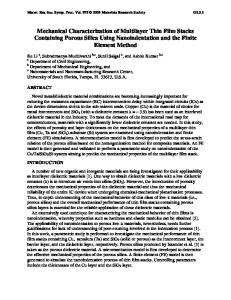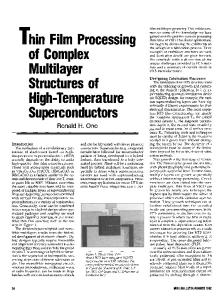The kinetics of indium/amorphous-selenium multilayer thin film reactions
- PDF / 310,006 Bytes
- 9 Pages / 612 x 792 pts (letter) Page_size
- 103 Downloads / 375 Views
MATERIALS RESEARCH
Welcome
Comments
Help
The kinetics of indium/amorphous-selenium multilayer thin film reactions K. Lu,a) M. L. Sui, and J. H. Perepezko Department of Materials Science and Engineering, University of Wisconsin-Madison, Madison, Wisconsin 53706
B. Lanning Lockheed Martin Aerospace, Littleton, Colorado 80127 (Received 12 September 1997; accepted 31 August 1998)
The reaction kinetics in vapor-deposited indium/amorphous-selenium (a-Se) multilayer thin films were studied using differential scanning calorimetry (DSC), x-ray diffraction (XRD), and transmission electron microscopy (TEM). A number of reactions were observed upon heating with characteristic temperatures which were found to be independent of the multilayer modulation wavelength. The initial interface reaction between In and a-Se is the formation of an In2 Se phase. Kinetic analyses of the In2 Se formation process combined with TEM observations indicated that interface reaction is characterized by the two-dimensional growth of pre-existing In2 Se regions formed during deposition to impingement in the plane of the original Inya-Se interface. The change of the density of In2 Se grains with temperature was analyzed in terms of the derived kinetic parameters, which is consistent with TEM observations and the heat release measurements.
I. INTRODUCTION
Polycrystalline chalcogenide materials such as CuInSe2 (CIS) have been studied extensively for photovoltaic applications due to their favorable band gaps and relatively high absorption coefficients.1,2 In laboratory scale fabrication, devices have been produced which exhibit stable and efficient thin-film solar cell operation.3 At the same time, the structural, morphological, electrical, and optical properties of CIS films and the corresponding device performance have been shown to depend highly on film composition and/or defect chemistry, which in turn are greatly influenced by growth parameters such as substrate temperature and deposition rate.4 The processing during synthesis of CIS films appears to be one of the most important areas for investigation to control properties and device fabrication procedures. The existing processing strategies usually involve semi-empirical recipes based upon the initial deposition of Cu-rich CuSe12x that offers a suitable template (large, columnar grains) for further reaction under an In-rich environment to convert the initial deposit to the desired CIS product. While it is clear that vapor phase control is essential for the most effective product, the existing process model involves an overall reaction that is mediated by a liquid phase that is proposed to originate from
a)
Also with State Key Laboratory for RSA, Institute of Metal Research, Chinese Academy of Sciences, Shenyang 110015, People’s Republic of China. J. Mater. Res., Vol. 14, No. 3, Mar 1999
http://journals.cambridge.org
Downloaded: 07 Dec 2014
the Cux Se12x phase and to serve as a flux medium for the columnar growth of CIS. Under a Cu-poor environment the final stage for the processing of
Data Loading...










